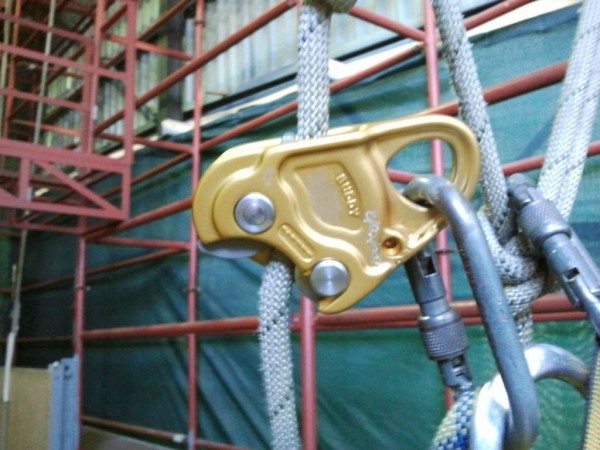Rope Access Inspection’s L3 has spent the last week in the training center utilizing the DMM Buddy for a variety of rescues and rope access maneuvers, ranging from basic L1 rescues, to advanced L3 rescues.
The following information is the opinion of RAI and each and every technician needs to use their own discretion and risk assess the specific application.
* The DMM Buddy conforms to EN 353-2 (2002) which is “Guided type fall arresters for use with flexible anchor line” this is not exactly a standard for a back up device, in the Buddy’s defense neither is EN 567 (Shunt), but the Shunt has a track record of over 20 years, the Buddy does not.
* For normal operation the following points were noted: – For ascending, work beautifully…..IF the rope is slightly loaded (tied at bottom, or weight of rope on long drop), but needs to be pushed high, or connected to chest or back D-ring. – For work positioning, tends to fall down and if connected to “even” a short cow’s tail, tends to put technician in a FF2 position. – For descend, works 50% of the time….if connected straight to chest D-ring, we don’t know about you, but 50% of the time tends to be VERY frustrating.
* The Buddy cannot be towed, or disengaged during a fall. BUT if held just right, at the right time, it might potentially “NOT” arrest a fall.
* The Shunt can be towed, holding the string “even lightly” could cause the cam to not engage during a fall. This is where the Petzl ASAP EN 12841 Type A device is truly a hands free device that cannot be disengaged by grabbing the body of the device during a fall.
* According to manufacturers instruction the DMM Buddy “must not be attached to more than one person fall arrest system”, and from testing, during a 200kg weight drop test (simulated 2 x person load) the Buddy does what almost all cam’d devices of this design do, damage the rope severely. So 2 person rescues are a no no.
* When using the Buddy as a intermediate point for mid rope rescue, it works well when loaded, but you can’t just slap the Buddy above your head and expect it to stay put with one karabiner, the Shunt does this really well. The primary difference between the Shunt and the Buddy, is that once the Buddy is loaded it slips very little if not at all. The shunt can be placed in the desired location above head, but tends to slip once minimal load is applied, and only locks onto rope once more force is applied.
The DMM Buddy is a very beautifully designed and manufactured device, but on a practical note, it is not the answer for use as a rope access back up device. We as a company are excited to get our hands on the Buddy Catch and look forward to the innovation from manufacturers world wide regarding rope access back up devices.
Regards
Rope Access Inspection

